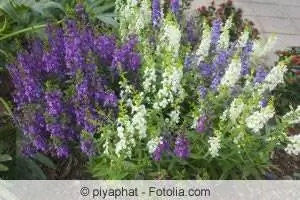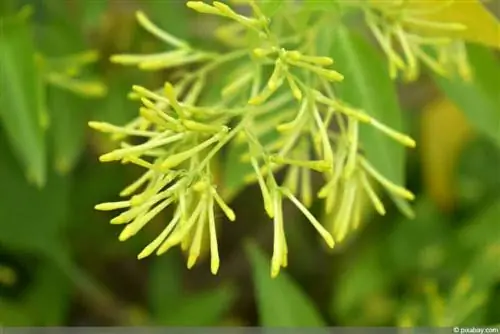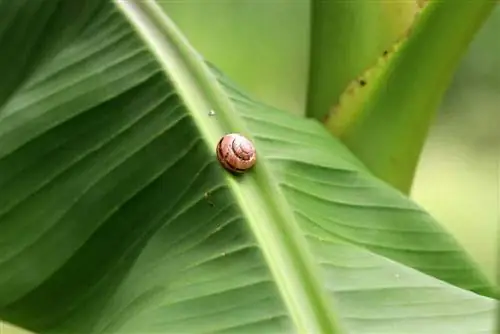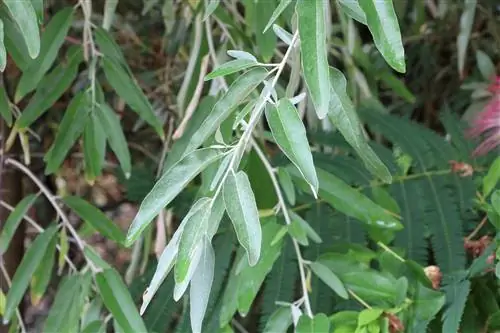- Author admin [email protected].
- Public 2023-12-17 03:39.
- Last modified 2025-01-24 12:45.
The Angelonia angustifolia, which is often simply referred to as Angelonia in the trade, is a very popular plant that looks particularly good on balconies or in plant bowls. In order for the plant's splendor to be particularly generous, it is important that not only the location is carefully considered, but that a lot of care and possible overwintering are also taken into account.
Location

The right location can significantly influence the development of a plant. While some plants like it shady and cool, others enjoy growing and thriving in the blazing sun. Angelonia angustifolia is one of the plants that likes it very sunny. It should therefore be ensured that this preference can be well served so that the Angelonia angustifolia can thrive. In return, there are few restrictions on space for planting. The Angelonia angustifolia grows just as well on the bed as in a planter on the balcony or in a planter that fits on the terrace or window sill. Please note the following:
- Place plants sufficiently far apart, as the Angelonia angustifolia grow quite quickly and therefore require a lot of space
- also get along excellently with other plants in bowls or in balcony boxes
- Planting can be carried out at constant temperatures above 10 °C
Tip:
If a place in the sun all day is not possible, the plant will also be satisfied with a partially shaded place. However, the growth height may be somewhat restricted.
Care
As a rule, Angelonia angustifolia is said to be quite easy to care for and uncomplicated. For planting, it is sufficient if the Angelonia angustifolia is placed in conventional potting soil. However, if you want to do it particularly well, you can add some mature compost to the potting soil. This gives the Angelonia angustifolia lots of nutrients that will further promote growth. A slow-release fertilizer can also be added from time to time. Here it is enough if this happens twice a year. If you plant Angelonia angustifolia in the garden, the beautiful plant will be most happy in loamy or sandy soil.
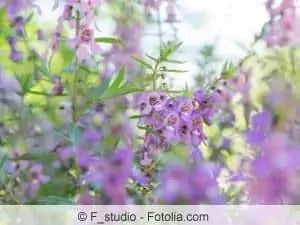
As the plant constantly grows back, it is ideal as a cut flower. If it is trimmed regularly, then it is important that fertilization is increased. Cutting the plant takes a lot of energy away, which has to be replenished in this way.
Tip:
It doesn't always have to be chemical fertilizer. Maybe there is mineral water with sparkling water that should no longer be drunk? If you give this to the plants, they will love to absorb the water and use the important minerals from it for growth.
Otherwise, it is very important that no waterlogging occurs when watering. The plants love water, but don't want to stay in it permanently. Watering should not be forgotten, especially during the flowering period from May to October. Ideally in the early morning hours or in the evening when the sun is no longer too hot. Then the Angelonia angustifolia can use the added water in peace and get the most out of it. Withered petals should be removed regularly. They only prevent the plant from growing and also don't look very nice visually.
Wintering
Angelonia angustifolia originates from Brazil. She is therefore used to quite warm temperatures and high humidity. However, since we have quite cool and sometimes snowy winters in our latitudes, Angelonia angustifolia is more likely to be seen as an annual plant. Despite all this, there are some gardeners who try overwintering again and again. However, this requires some measures. The plant must be protected as soon as temperatures fall below 10 °C. It is important that not only is the plant well packaged, but that the soil around the plant is also protected. The best option is a frost protection film that can be used to cover. Before covering, the panicles should be cut back. Despite all the measures, it may happen that the Angelonia angustifolia does not survive the winter. Because when the ground freezes, even the best plant protection can have little effect.
For this reason, stubborn gardening enthusiasts should look for a warmer place for the Angelonia angustifolia in winter. If the plants are in a balcony box or in bowls, they could be brought into the living room in winter. Maybe you can find a sunny spot on the windowsill or in the winter garden. It is important that temperatures are above 10 °C. A place in the basement or garage, however, is unfavorable because sufficient temperatures may be reached there. But the darkness will not be beneficial to the plants and will cause them to wither.
Tip:
In the cooler winter months, Angelonia angustifolia needs significantly less water than in the warm summer months. Watering must be adjusted accordingly. Waterlogging must be avoided at all costs. And fertilizing can also be stopped during the winter months.
Frequently asked questions
Are there any special care instructions?
The Angelonia angustifolia is a very grateful plant and grows under completely normal conditions. All she wants is enough water and lots of sun. However, when it comes to water, care must be taken to ensure that no waterlogging can form.
Where can Angelonia angustifolia be planted?
It grows just as well in the garden on a large bed as in a box for the balcony or in plant bowls. The planting distance should only be large enough so that the plants can spread and develop well.
What about wintering?
Actually, Angelonia angustifolia is not suitable for overwintering. Thanks to its origins, the plant likes it warm all year round. Overwintering will therefore only work if the plants are either covered with frost protection film or if they are placed in a warm and, above all, sunny place in the winter months. The temperatures must always be above 10 °C and the plants should be cut back before overwintering.
What you should know about Angelonia in brief
Care
- Caring for Angelonia begins with selecting the correct location for this plant.
- The Angelonia can find its home in the garden bed, in planters or as a balcony plant.
- However, this flower particularly likes the sun. Places that are too shady are therefore not the optimal location.
- Instead, you can give it the most joy in a sunny to partially shaded place.
- Ordinary potting soil is suitable for planting angelonias. You can add a long-term fertilizer to this.
- However, the angelonia feels most comfortable in loamy and sandy soil.
- Liquid flower fertilizer should be added to the irrigation water at regular intervals.
Tip:
Thanks to its tireless growth, the plant can also be used as a cut flower. However, this constant regrowth, combined with the long flowering period, which lasts from May to October, costs a lot of energy. Accordingly, the Angelonia should be freed from unnecessary ballast. Withered petals should be removed regularly.
Irrigation
- The Angelonia tolerates drought very poorly. That's why you should pay attention to sufficient moisture when caring for it.
- However, you won't get any waterlogging at all, so watering must depend on the humidity of the Angelonia's soil environment.
Wintering
- Angelonia is a plant whose original homeland is in Brazil. Accordingly, this genus is used to rather mild temperatures.
- Since the local winters are associated with long-lasting cold temperatures around freezing point, the angelonia is considered an annual plant in this country that dies in the winter.
- So it is absolutely not hardy. Temperatures can drop to 10 °C without causing damage to the angelonia.
-
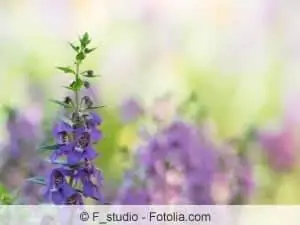
In this country, Angelonia can hardly be overwintered If you still want to risk overwintering this plant in the garden, you should definitely cover the entire soil in the flower area with frost protection film.
- The panicles should also be cut back. They can also withstand slightly lower temperatures with a protective foil cover.
- The chance of survival remains extremely low given the usual winter temperatures in this country.
Tip:
If you want to be on the safe side, you should bring the Angelonia into the house to overwinter. For this very reason, the angelonia is increasingly found as a balcony or container plant. But digging it out of the flower bed and putting it in a pot is also an option. However, garages are not the right overwintering location for angelonias. It's too dark there and too cold. Instead, a sunny spot in a bright room is perfect.
As an important note, it is important to note that you have to be careful when adding moisture, especially at low temperatures. The colder it gets outside or the cooler the room in which the angelonia is to spend the winter, the more sparingly you have to be when watering and fertilizing.

